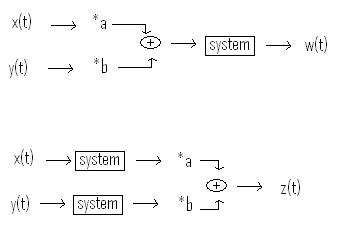| Line 5: | Line 5: | ||
This is saying that if i have 2 inputs of x(t) and y(t) and put them through a system, then multiply the 2 outputs by a constant, and add them together to get my final signal i should get the same if i multiply the two input signals by the constant first and add them, then send them through the system. | This is saying that if i have 2 inputs of x(t) and y(t) and put them through a system, then multiply the 2 outputs by a constant, and add them together to get my final signal i should get the same if i multiply the two input signals by the constant first and add them, then send them through the system. | ||
| − | + | [[Image:SystemsPic_ECE301Fall2008mboutin.jpg]] | |
| − | . | + | |
| − | + | ||
Revision as of 07:05, 12 September 2008
Definition of Linear System
A system is considered linear if for any constants a, b that exist within the complex domain and for any inputs $ x_1(t)\! $ and $ x_{2}(t)\! $ yielding outputs $ y_{1}(t)\! $ and $ y_2(t)\! $ respectively, the response to $ x_1(t) + bx_{2}(t)\! $ is $ y_1(t) + by_{2}(t)\! $
This is saying that if i have 2 inputs of x(t) and y(t) and put them through a system, then multiply the 2 outputs by a constant, and add them together to get my final signal i should get the same if i multiply the two input signals by the constant first and add them, then send them through the system.


